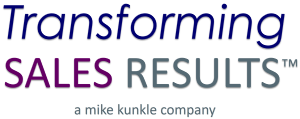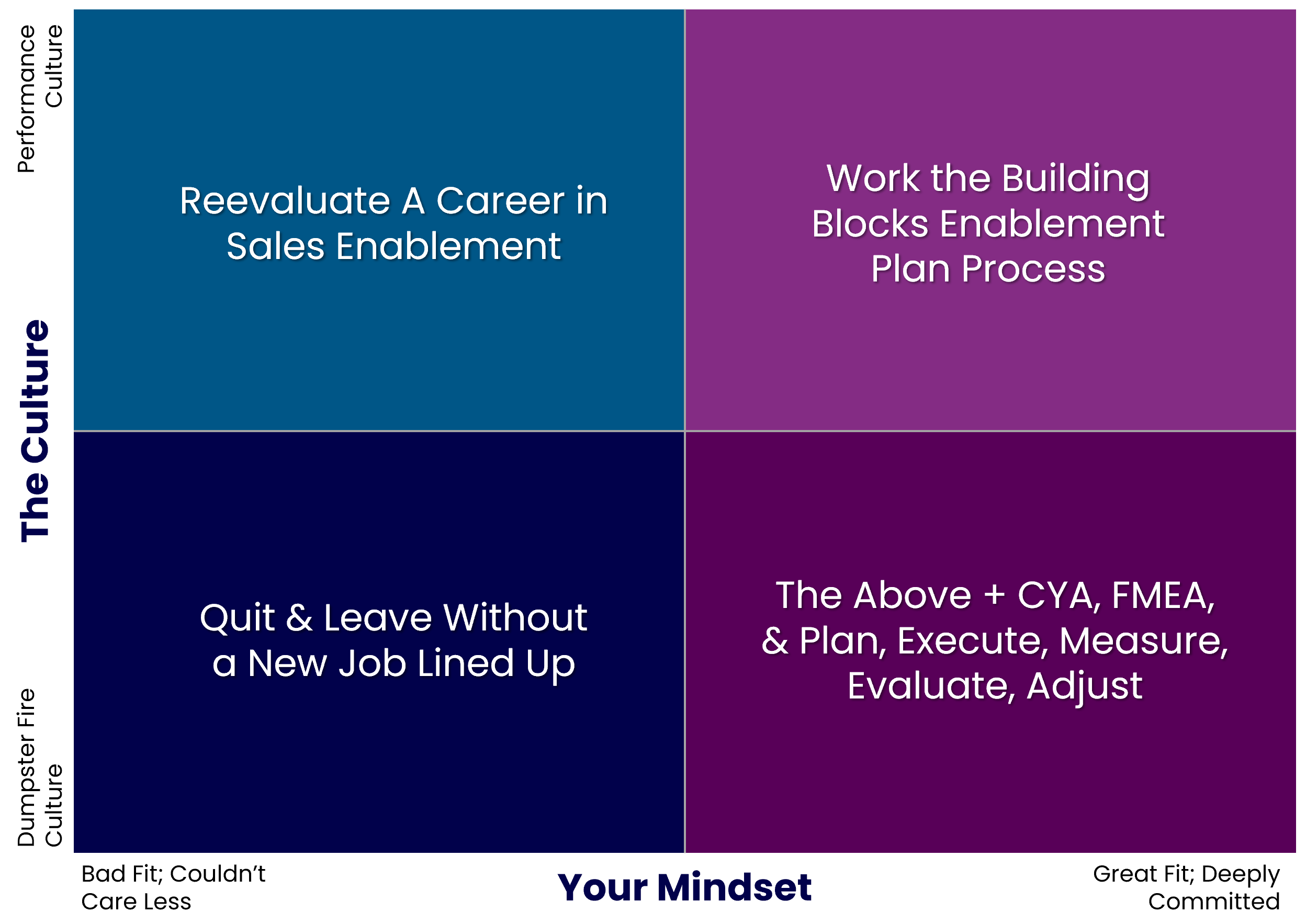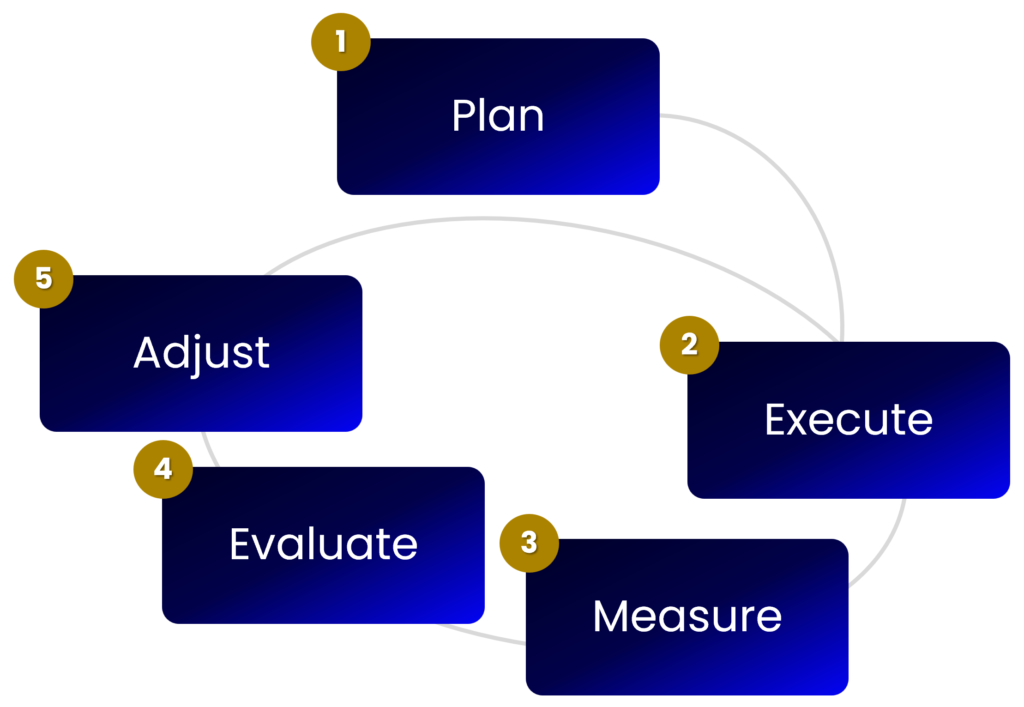Enablement is Hard. Do It Anyway.
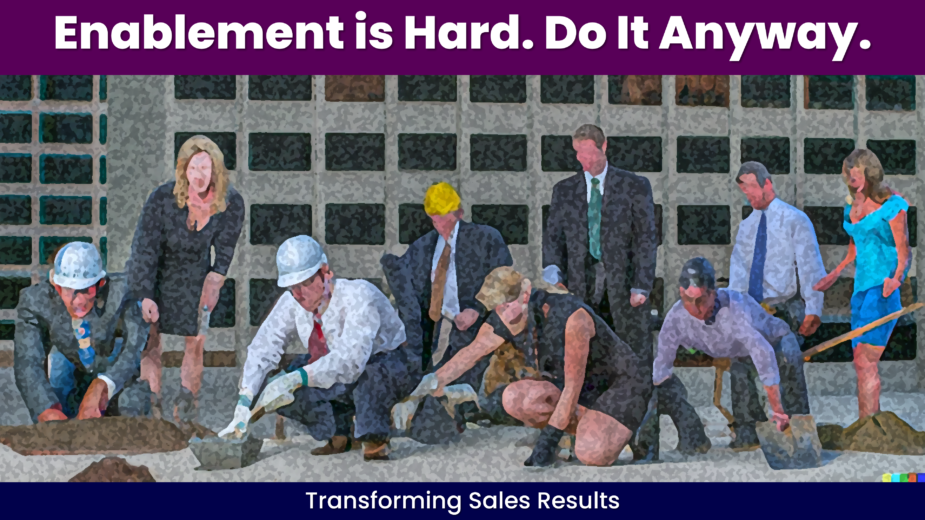
Purposefully orchestrating organizational performance improvement is difficult. It requires a wide range of knowledge, skills, capabilities, practices, and mindsets, as well as mental toughness, emotional maturity, and, often, the ability to influence without authority. It’s organizational behavioral change management, for sure, and requires both smart and hard work.
The goal of “enablement,” whichever term you use for it (sales, revenue, buyer, buying, performance, other) is ultimately to improve organizational performance.
Therefore, enablement is hard work.
See what I did there? Logic is our friend.
As with most things, on the front lines of the real world, it’s a bell curve. It’s like the age-old nature versus nurture debate. In addition to your capabilities (the “nature” side – how you are wired and the knowledge, skills, attitudes, and behaviors that you bring to the table), there are environmental factors at play (the “nurture” side – the culture, leadership approach, policies, practices, processes, and more), that ease or complicate the work we do and influence our ability to produce both meaningful outputs and compelling outcomes.
Sometimes, that reality being what it is, we need to work in environments that are not ideal for what we do. Some environments (and company leaders) do not support root-cause diagnosis, effective solution design, sound implementation, and the adoption, behavior change, and mastery that are required to improve organizational performance. There are also other factors at play, such as product-market fit, strategy, the chosen sales model, organization design, or lack of top-down support, that also influence our work. I’ve written about this challenge before in this post, There Are Limits to What Sales Enablement Can Fix. This remains true.
So, enablement can be hard under the best of circumstances, and gets harder in less-than-ideal environments.
Career Musings
I’ve been thinking about this a lot lately, due to the many downsizings and layoffs that have occurred, and how many good enablers are in the job market right now.
Many of these enablers are between “a rock and a hard place,” as my dear ol’ mom used to say. They know that the place they choose to work (the environment, especially the attitudes and behaviors of senior leaders) will radically influence their ability to make an impact with enablement. This can affect their success in the role, their reputation, their continued employment, and even their career trajectory.
At the same, there’s a burn-rate and a runway for unemployed individuals, much like for start-ups. Unemployment and savings will only carry you so far. Sooner or later, some of these enablers may need to accept a position that is less than ideal, for the sake of their or their family’s well-being.
In addition to knowingly joining a less-than-ideal environment, there are also unexpected left-turns, where the reality of the culture and environment turn out to be very different than what was forecasted during the interview process.
Now, get ready for some tough love.
Finding yourself in one of these situations does not excuse you from working as hard and as smart as possible to make an impact with enablement.
Whether or not I’d suggest you continue to seek a better environment (which is an option I do recommend in the worst cases), depends on whether you believe your situation is hopeless and unchangeable, or whether you believe you will be able to make an impact, even if it’s less than the potential impact you could make under better conditions. Which, earlier, we said wasn’t easy either.
So, what’s an enabler to do?
Speaking of hard, it’s not easy to give generic advice about this, since so much of it is contextual. But I’m going to walk my talk, and do the hard thing anyway, as best I can.
Let’s dig in.
What You Must Do
First, stop whining. Stop the negative self-talk. It’s hindering your chance of success.
How? Have a purposeful pity party [timeframe of your choice; no longer than a weekend]. Bitch, whine, complain, and feel sorry for yourself. Get it out of your system. Then, at your pre-determined time, switch to a diagnostic, problem-solving mode. Remain somewhat pessimistic during the planning, if it helps maintain realism and avoid rose-colored glasses or what I call “Hope Goggles” (see this post from Effectiviology on a pessimism bias and when it can be helpful), but get out of self-pity mode quickly, to decide your course of action.
To help with the above decision:
- Conduct a realistic Situation Assessment and Force Field Analysis on your current circumstances. Not of your sales force and not to build a sales enablement plan, as you normally would, but to help answer the “should I stay or should I go” (SISOSIG) question. (Sorry, it begs for an acronym.)
- As part of that analysis, you should also create a Buyer Landscape Map (aka Relationship Map) to assess the people/politics side of the equation.
To avoid rewriting another entire blog post, see this post on How to Radically Improve Your B2B Sales Win Rates, and apply that very same advice about the Situation Assessment, Force Field Analysis, Buyer Landscape Map, Value Stack, and Value Drivers to your above analyses. These are really consulting methods, yet they work very well for sales enablement, as well as sales.
I can give you the tools and I can give you advice, but this is a decision you must make for yourself, based on your specific circumstances, your ambiguity tolerance, and your confidence in your ability to navigate the challenges you’re facing.
[click the image to see a larger version]
This graphic is grossly oversimplified as a 4-box matrix. It’s really a sliding scale on both axes with more action options in-between, but hopefully, it makes the point.
How to Plan to Make an Impact with Enablement
If you decide to stay and do battle (I don’t normally like war metaphors for business, but it’s apt here), then your go-forward approach:
- Should not be that much different than what you’d do normally.
- But must consider the outputs of your above SISOSIG analysis.
The Approach

[click the image to see a larger version]
So, as you progress through these steps, you should factor in the data and information from your previous analyses but follow your normal planning process. The steps I recommend and teach for developing a sales enablement plan that deliver results are:
- Develop a Sales Enablement Charter
- Conduct a Situation Assessment on your Sales Force
- Conduct a Building Blocks Gap Analysis
- Conduct a Force Field Analysis
- Create your Sales Enablement Plan
And for you, in this case, I’d add a step:
- Prepare for Likely Contingencies (aka, CYA Plan)
In your current situation, you will likely need to prepare for contingencies. These will be driven by whatever it is in your environment that makes it less than ideal. It could be working for a Master of Disaster (an executive who constantly overreacts to the last thing that went wrong), Bright Shiny Object Syndrome, a lack of top-down support, regional fiefdoms versus an aligned org structure that reports to a centralized senior sales leader, a marketing leader who sees enablement as just training, or one of the many other challenges we face in the real world of enablement work. It’s hard for me to know what those will be for you, but you’ll know – so you’ll need to be ready to adapt.
Another thing that could be very helpful, in this case is a Failure Mode and Effects Analysis (FMEA) from Six Sigma. It’s designed to help you identify projects risks (how could this fail?) and avoid them, or at least be prepared for when things don’t work as they should, and adapt. This is something that would be beneficial for most enablement pros anyway, but it’s certainly applicable in less-than-ideal environments. Here are three resources to learn more:
- Article on FMEA from Quality-One International
- Article on FMEA from ASQ
- Video on FMEA from Gemba Academy
For the remainder of these steps, they are well documented elsewhere, including:
- In this webinar (free)
- In this eBook ($12.95)
So, after Develop a Sales Enablement Charter, I will refer you to those resources for the details.
Develop a Sales Enablement Charter
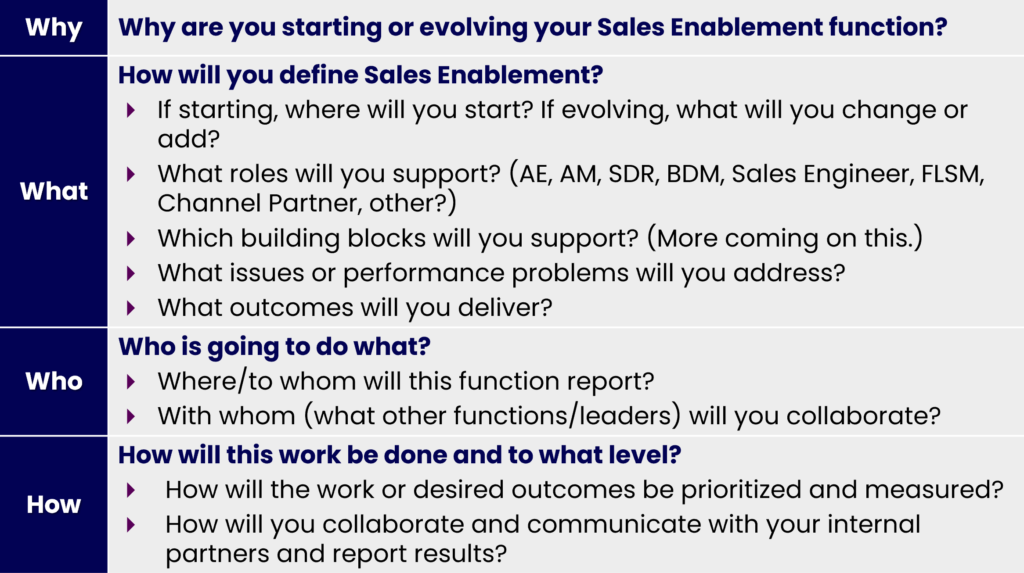
[click the image to see a larger version]
For this, I do want to recommend something special, given the likely challenges you’ll face in your less-than-ideal situation.
Use John Kotter’s change management advice and “Build a Guiding Coalition.” Start with the Bricks in the Wall, as I call them, or the other stakeholders and cross-functional collaborators with whom you’ll work and build your sales enablement charter, as normal. But within your charter team, and based on the analysis in your Relationship/Landscape Map, network to find and develop your true supporters, or your “guiding coalition.” You’ll need allies, and purposefully developing them (as you’d guide a sales rep to identify and nurture a Champion in an opportunity), is wise in any circumstance, and doubly so, in a less-than-deal circumstance.
For the remaining steps, see the blog post already referenced above, as well as the webinar and the eBook, to optimize your efforts.
- Conduct a Situation Assessment on your Sales Force
- Conduct a Building Blocks Gap Analysis
- Conduct a Force Field Analysis
- Create your Sales Enablement Plan
Plan, Execute, Measure, Evaluate, Adjust
“It was the best of times, it was the worst of times.”
~ Charles Dickens
In the best of times, as we established early, enablement is hard. In the worst of times, it’s even harder. But we’re not always going to have the luxury of ideal situations.
In either case, a strategic approach to enablement that supports achieving the metrics that matter most to senior leaders is what will serve you, your sales force, your customers, and your company the best.
And, in either case, you’ll need great execution of your plan, with a measurement strategy, an evaluation of results (and when there is a shortfall, why), and the ability to adjust your approach to improve the outcomes.
[click the image to see a larger version]
In less-than-ideal circumstances, a rational tracking and approach like this is even more important. And, this is where your FMEA comes in, as well.
Prepare for Contingencies (CYA Plan)
Look, I am not a fan of CYA behavior, but let’s be real. In some politically-charged corporate environments, or in companies where you will be held accountable when you do not deliver results (even in an impossible situation), others may be looking for scapegoats when things don’t work. There’s a lot of pressure on executives, especially senior sales leaders, who turnover, on average, every 18 months. Authenticity, transparency, courageous conversations, and documentation are your friend.
“Be as cunning as the serpent yet as gentle as the dove.”
~ Adapted from Matthew 10:16 (in the Bible)
An example:
If you don’t have top-down support to hold front-line sales managers accountable to reinforce the qualification methodology you’ve implemented, and you don’t see a performance lift from the effort, you know why. It’s not a surprise. These are conversations to have in advance, when you are asking for what you need to deliver the results the organization wants. If I’m talking to my senior sales leader, Frank, about this, here’s what it might sound like.
“Frank, I agree that implementing a qualification method is needed for our team. I also believe that when it’s done well, it can produce the results we discussed. I’ve seen this happen elsewhere. I know it’s possible. I know you’re right.
I’m concerned, though, Frank, that we won’t get those results. It won’t happen without fully engaging our sales managers to inspect what we expect, to drill-down to validate qualification criteria and accuracy, and to incorporate these discussions into team and one-on-one pipeline and forecast reviews. That’s not happening today, and every time I bring it up, it’s not supported. Heads nod, but behavior doesn’t change. And since it’s not coming from you, and isn’t inspected by you with our managers, they’re just not doing it.
In my experience, that means that 10-20% of the reps will take this seriously, which means we’ll get between 10-20% of the results we hope for. If it turns out that I’m right, and I believe I will be, I want to go on record now saying so. I think we can do better. We’d just need to be willing to take a firmer stand on implementation and inspection, and truly hold people accountable for doing this, and learning to do it well.
What do you think, Frank?”
For some people, or in some cultures, or with certain leaders, that would be considered a “courageous conversation.” I think having these conversations comes with the role, but in some cases, it does also come with some risk.
If you’ve decided to stay and to do your best to make an impact, this is a necessary conversation. The above example is what I’d say. You might adjust how you do it based on your personality or your relationship with “Frank,” but it still needs to be done. Here are some resources for influencing without authority:
- Article on How to Influence Without Authority from THNK
- Article on How to Influence Without Authority in the Workplace from HBS
- Book: Influence Without Authority
Closing Thoughts
This isn’t a topic that gets openly discussed a lot, so I hope this post has been helpful. If you’d like to talk about any of these concepts or get some guidance, you know how to find me.
Thanks for reading, be safe out there, and by all means… let’s continue to elevate our sales profession.
Mike
Follow my work and connect
- The Building Blocks of Sales Enablement Book: https://bit.ly/BBofSE
- Sales Enablement Straight Talk Newsletter: https://bit.ly/MikeKunkle-LinkedInNewsletter
- The Building Blocks of Sales Enablement Course: https://GoFFWD.com/Blocks
- SPARXiQ Blog: https://sparxiq.com/author/mikekunkle
- Distribution Strategy Group Blog: https://distributionstrategy.com/author/mike-kunkle/
- Sales Effectiveness Straight Talk Webinars: https://bit.ly/MikeKunkle-OnDemand(60 Free Recorded Webinars)
- LinkedIn Articles: http://bit.ly/MK-LinkedInArticles
- LinkedIn Profile: https://www.linkedin.com/in/mikekunkle
- X (formerly Twitter): https://twitter.com/mike_kunkle
- Instagram: https://www.instagram.com/mike_kunkle/
- TikTok: https://www.tiktok.com/@mike_kunkle
- YouTube: https://www.youtube.com/@MikeKunkle/videos
About Mike
Mike Kunkle is a recognized expert on sales training, sales effectiveness, and sales enablement. He’s spent over 30 years helping companies drive dramatic revenue growth through best-in-class training strategies and proven-effective sales transformation systems – and he’s delivered impressive results for both employers and clients. Mike is the founder of Transforming Sales Results, LLC and works as the Vice President of Sales Effectiveness Services for SPARXiQ, where he designs sales training, delivers workshops, and helps clients improve sales results through a variety of sales effectiveness services. Mike collaborated with Doug Wyatt to develop SPARXiQ’s Modern Sales Foundations™ curriculum and also authored the SPARXiQ’s Sales Coaching Excellence™ course. His book, The Building Blocks of Sales Enablement, is available on Amazon and The Building Blocks of Sales Enablement Learning Experience is available through FFWD.
